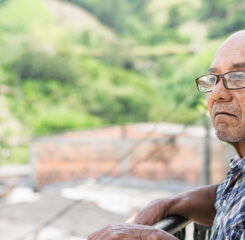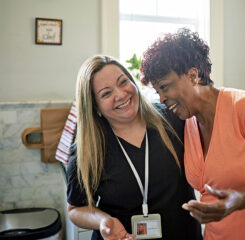LPC Advisory Group: Transitions through the Continuum
After introductions and announcements, Dee Pekruhn began the discussion with four questions for the panel. Below, the answers are summarized.
What do you think the current and future resident of an LPC is looking for in the continuum of care, nowadays?
· Barbara Thomas (BT) Through our research, we have found that prospective residents are still interested in the continuum, and by staying connected with them throughout the pandemic (newsletters, etc.) we have built a solid relationship with them. They are looking for safety, autonomy, ability to thrive even in the most difficult of circumstances.
· Brad Paulis (BP:) It’s a complicated answer. Older adults will say that they want to be able to “age in place,” but they also do not want to live next door to someone who is aging in place. It matters to new residents the ‘age and vitality’ of the people they are living near. There is heightened scrutiny right now. Preparing people to transition needs to be all throughout the process of living in the community, beginning with marketing and all the way through to Assisted Living. Also, people need to know how they will be treated when they have an acute need. The pandemic gave us a great time for folks to observe what happens (when acute care is needed.) Great time to see how a community can connect in difficult circumstances; we demonstrated that people would be supported, connected, and cared about.
· Indira Palekar (IP:) If you provide residents with more information, they can read and interpret for themselves. Everyone is looking at the wellbeing component, they want to be secure and free to live their lives. Emotionally and psychologically it is a different matter, and a tight balancing act. Have to find the balance between what is best for the individual and what is best for the community.
Why do you think some residents are hesitant or even resistant to moving to higher levels of care? What is the best way to encourage them to make the transition, when the time is right? How do you determine when that time is?
· BP: Residents desire the best quality of life for themselves and their loved ones. The trap is that we define this as “independent living” when at times the best quality of life can be found in the health care setting. The time to demonstrate that is not in the time of need, but rather in the years prior.
· IP: It’s not at the point of transition that you should talk about the move. It should be touched on when people move in. The design of the community can help. And it’s really about fear – loss of independence, loss of autonomy, death, decline – so many levels of fear that come into it. This needs to be addressed organizationally by bringing these topics up right at the beginning, when they move in, and expose them to the higher levels of living. This is so they can see how others are doing, how is their care; people can see that they will be OK when it’s their time to move. It’s important to help people find internal peace with their own aging and the decline that comes with aging; a balance of internal and external work getting ready to transition. Building trust starts at the very beginning. People need to feel they are being heard, even in small matters. Teamwork and developing the relationships is also key.
· BT: Readiness is most successful when the person who needs to transition is at the center and trustful of those guiding the process. The relationship with staff is key, along with the relationship with family. Sometimes we put in interim steps to help people, but we see it is usually six months. Open communication, building that trust, recognizing that it’s the person and the support is there from the team. Regular check ins and support to see how things are going. Readiness will come if the trust is there and the person is at the center. It makes all the difference. The period of the pandemic closed off the natural pathway through the health center to the fitness center. With those doors, it changed the normal pathway. All those years, they see people being cared for and maintained in their relationship with others. Intentional design makes all the difference, and resuming those normal pathways is something we look forward to and is a big part of our success.
Can you describe a little further, how do you help people be heard and how do the pathways help maintain the connection with friends and neighbors in IL?
· IP: We have a great social services department, and they are very good at connecting with people and discovering the issues. They talk to residents about the situation and ask what are they hoping for, what is their goal, what is not satisfactory to them. We discover what is not working and where they are coming from, and then address the logistics. The information has to come from the resident, spending enough time listening and collaborating to resolve the issue. How are they going to feel at the end of the conversation is what’s important. What is realistically important, what is possible, and then do the collaborative work.
· BT: What makes transitions more comfortable is how much a community can integrate the activities. We had a resident transition from IL to AL who loved table tennis. Listening to jazz, participating in exercise. IL resident integrate into activities no matter where they are held. This helps maintain relationships. Residents may eat wherever they wish, there are no limits (except during pandemic times.) We don’t want relationships to end just because of a move. Activities that help build relationships and holding trial visits or respite stays can help people get comfortable with the idea of transitioning. Must be very disciplined planning.
How do you balance “the best interest of the individual” with “the best interest of the organization” when the two are not in step? What policies should be in place to ensure there is a reliable decision-making schema for that to happen?
· BT: It starts with your contract and the details there are important. In more cases than not, we go the greater mile to assist people in making a move. Sometimes we slow down the process to keep the resident at the center of the decision. There are best practices in keeping the staff aware of how the situation is changing. The contract is there to be the biggest support if necessary. If you work the process through and use their healthcare network, you can facilitate the transition. We encourage residents to consider a broader healthcare network such as a good friend or neighbor who can assist as an advocate or supporter. We work together to make decisions to best serve both the individual and resident. I remind people of the choice they made when they picked a CCRC and that support would be in place when they could no longer make their own decisions – it was the best decision they made and we are here to deliver on that promise.
· BP: Meeting the resident’s physical and emotional needs is in the best interest of the organization. This filters to marketing and operations, everything. Having those details in the contract and knowing how to address it in a loving manner is so important. Having those policies in place if you need them, but that is not common that you have to use them.
· IP: If the resident is resistant to moving to a higher level of care, talk with them about what is in their best interest. Where will you feel more secure, taken care of? Where can is your energy better spent: the difficulty of self-care that is becoming harder, or something else more meaningful? Broaden their perspective and how they are looking at it; you have to remember that it hard for them to think about giving up IL and going to another space that is more restrictive and offers less privacy. You can help them widen their perspective and look at it from all different angles.
· BT: A move today is not as straightforward as it was before the pandemic. There are more restrictions and it puts a different light on the ease of making those transitions. Our housekeeping and dining staff, the challenges they have of caring for a resident who is not being best served in Independent Living – they see it, we see it, the family sees it, and yet we are trying to recognize this is not the easiest time (during the pandemic) to make a move. The rules have changed, and we’ve had to adjust, and people have held on longer. We are coming out of the pandemic, and we hope to get back to where we were and use the supportive resources we had prior to the pandemic. Our modifications to our process have made us a stronger organization, and our residents appreciate and trust us more now because they see how well we’ve cared for them during the pandemic. The staff have been phenomenal in how they have adapted in their roles. They have recognized the need to modify their jobs and they have done it willingly. We have come out of this a strong organization to be sure.
· IP: Residents have come together and supported each other as well.
What are the financial implications of when we make these decisions of who should move and who can age in place? How does that affect your financial planning and future solvency?
· BP: Most CCRCs were built under a certain assumption of a certain level of turnover, and that turnover of entrance fees is used to pay down debt and for capital expenditures. Regardless of turnover in the health center, the long term, the change in transfer rates is not as significant. There’s other implications – the space it takes to house people in the nursing home, per diem’s are reduced, the other expenses. On the other side, if fewer people transfer, that can free up space in the health center that can be used for other revenue producing activities. From a master planning standpoint, as transfer rates change, as resident desires and needs change, those issues can be worked out. The financial piece doesn’t have to be the overriding determining factor of where a resident belongs; it really should come down to where the resident’s physical and emotional needs can be best met.
· BT: First of all, we need to have lots of ways of delivering services. We had years where our health center census was full and we had to have other options to address people’s needs. We have built in ways to meet needs in IL residences, and we have a great partner for that. We do not have any history of people in IL hiring companions; this has never been our practice. People are not living on the premise that someone else can assist them to live in IL. Certainly if that were different, it would have a financial impact on us and would slow down the transition. I’ve always understood, actuarially, that it’s based on our decision making, and on our specific history. There’s no right model, but all LPCs need the ability to deliver services in the IL setting. Ultimately, you have to have a plan and process ready for when the day comes that an IL resident needs to transition. Our residents count on us to work with them personally when the time comes.
If you could redesign the continuum of care from the ground up, how would you do it? What would you change? What would you keep the same?
· BP: I would have flexible space in the health center. Resident desires and needs have changed in the 30 years I’ve been consulting. Have the flexibility to change your healthcare setting. And, the integration of resident flow – that’s not very common. Most LPCs havwe the health center in a separate building. When it’s integrated, it makes it less scary to move. And, the intentionality of design in IL to facilitate aging in place – mechanized carts, roll in showers – giving people the ability to age in place.
· BT: We are a 28-year-old community and we are master planning for our health center. We turned down an otherwise great plan because it would have taken down art exhibit walls in the health center. Art at Oberlin is very significant. If we did that, it would completely change the sense of entry into the health center. It’s very striking when people walk in and they see the art; the art is always changing and the installations are professional. Those walls are important, and we are going to keep them even though it meant we wouldn’t be able to open up the dining room as much. So many people pass through that area through all parts of our campus. I look at things that make it so you don’t realize you’re in a health center – the presence of art, music, private bathing spas – those things that you like to have in your own home. Remove any of those signs that make it look institutional. Newer architecture is really getting to what people want – more like home in every way possible.
· IP: I would not separate spouses as they get older and need different levels of care. Figure out a way for them to stay together. I would not move them from one space to another space because their level of care increases. I would keep them together and bring the care to them. Also, they would be allowed to keep their pets, these are a part of their family. And, move the nursing station out of the center, to create a more homey approach.
· BT: We have more couples in our healthcare center than we’ve ever had. Some use one room as their bedroom and other as their living room space. This is intentional. And we have to have the pets. We should never separate people from their pets.
Next, Dee asked the panel questions from participants on the call.
Given that the levels of care are important, why are some life plan communities thinking about decreasing or not having a NH? Resident leaders are also saying they think more personal care services should be delivered in IL.
· BP: I think it’s because of the evolution of assisted living or personal care. The way care is being delivered has changed a lot over the last 15 years. So much care can be effectively done in personal care so that there’s a lot of care that doesn’t have to be done in a nursing home. The pandemic had greater restrictions on nursing homes than assisted living, and lots of push back from residents over that. There’s been movement away from having those skilled beds because the care needs don’t change, but how you deliver to meet those care needs can change. That’s why I think flexibility in health care delivery and design is so important. We are seeing a movement to greater personal care and less skilled care. Not changing how much care is being delivered but where it is being delivered.
· BT: We have reduced from 42 skilled beds to 12, and I think we’re going to drop down to 5. Our challenge in our state is that we are controlled in Ohio; we cannot deliver personal care services to three or more individuals in an independent living setting without relicensing those to a residential setting. We work through our partner to get home care services. I’m very supportive that we can do medication medication administration, for example. This integrates well into the IL setting. When you need too many supports to support that person well, then you start talking about the need to transition. But I think you want to delay it as long as possible.
· BP: The healthcare needs haven’t changed, it’s just a question of how you deliver services to meet the needs. Truthfully, you don’t know what residents 20 years from now will desire. Being able to maintain flexibility is what’s key. Right now, coming out of the pandemic, there’s a bigger stigma to skilled nursing. That health care need hasn’t changed.
· BT: And then we have to ask, will we have the workforce to deliver services in a spread out campus? A resident recently moved to our memory support, and she is beaming about her move. She felt for sure she wasn’t going to like it, but we were patient with her, and she came to the decision herself that it was the right move for her. If we give people time, and if we can find the workforce to deliver the services where they are needed, it still must be efficient, effective and affordable. We have to have a workforce who can deliver on it.
Can you offer any specific strategies or examples of how you worked with a resident who refused to transition to the Health Center despite their medical needs or safety concerns?
· BT: You stay connected. The team, the family, the physician, and the resident at the center. It’s not overnight. It usually doesn’t have the need to be overnight. These are often months or a year in the making. Take the extra time, it’s so important. You may have to draw a line if the resident’s life is at risk. Otherwise, it’s just getting them more ready and a part of the decision. The strategy is to stay with the individual and don’t give up. It takes a team. Sometimes it’s the housekeeper or maintenance worker. Pull the team in who has the relationship with the resident. You can’t just draw a line and force a move. And neighbors and friends see that, they see whether you keep the resident at the center of the decision or not, and it sets up their expectation for a transition when it’s their time.
· IP: It’s about sitting with the resident and talking about the pros and cons, asking what’s working right now, and what’s not working right now. How can you help them make it work. Provide them with support. Help them find ways to make things work. The time will come when it won’t work- then explore the other opportunities within the community that can help. It’s a very slow transition for them to begin to see there are services available, so they don’t have to struggle so much. Very slow and you just have to be patient and connect with them, be a collaborative partner.
· BT: Having Indira be a key part of our team has been invaluable. She is a great partner and supporter to residents. Have a resource on your staff that residents look up to and trust. Get the best you can – get an Indira! It’s a part of your toolkit to have a wonderful resource on your team.
Following the facilitated discussion, Dee asked these questions of the members present; their answers here are summarized.
To what degree do you support “aging in place” in your community?
· Every year I hold a transitions program where I have all of the department heads and key players of the continuum present – I also record these sessions and replay them on the in-house TV.
· Transitions has become a growing interest to the Facilities Department here at Kendal at Hanover. The services and operations in independent living are very much different from the Facilities Department. Getting the transition correct has impact to the resident, staff, finance… and the business model of the organization as aging in place at the extreme requires rethinking the building itself and our operations within it.
-I would also say not make such a big distinction between levels of care in apartments styles, areas etc. so that it does not seem like “downgrade” they see it as a step down at least here. I would suggest aging in place is going to continue on and off campus. I agree with Indria completely.
· We fully support residents having the option to remain in their apartment as long as they want to and are safely able to do so. As all our IL apartments are licensed as RCFE by CA, the regulations are probably the greatest barrier.
· Definitely build less AL and SNF and focus on Ind with services for sure. Most again, would age in place.
· We do all we can to see that all ADL’s are met continuously (with or without assistance). Family can help, paid caregivers can help, even neighbors can help (with limitations of course). When the ADL’s are not met continuously our interdisciplinary Transition Team steps in to advocate for the supports that are needed or to recommend the move to a higher level of care.
· We have established a licensed home health care agency on campus, providing homemaker, personal care and nursing services to allow Independent Residents to have a bit more support in their IL setting, and on a scheduled basis. This allows us to be even closer and more involved with our more needy Residents, and allows us to promote a transition to a more appropriate level of care.
· We partner with residents/families to allow residents to age where they want, so long as that resident and their neighbors can be kept safe and we can find a way to meet their needs. The biggest problem for that is trying to meet unreasonable expectations of the family when memory issues are the lead driver.
· We allow residents to age in place–Sometimes a resident in Independent Living may choose to age in place with a care giver, but they don’t socialize with their peers and care givers sometimes enable residents to be less independent.
What is the greatest barrier to managing transitions in the continuum where you are?
· Open spaces and similar home like design at every level of care. All program areas should invite residents into various living spaces and it should feel like home. All spaces should look similar. Older physical plants are challenging.
· Also in my market nobody wants one bedrooms anymore.
· Age and design of the physical plant. JZ at Carmel Valley Manor
· A lot of the time our “care” living design is still older, personal care, rooms rather than something that discourages residents. Biggie is amazing limited storage…not even enough for seasonal change of wardrobe. Gotta wonder what kind of message that sends.
· They see more disabled residents already with walkers and scooters all over the place. We have to work harder on the LA vision about ageism!

Most Recommended
October 15, 2025
 Shutdown Week Three: Impact of Ongoing Closure on Affordable Housing
Shutdown Week Three: Impact of Ongoing Closure on Affordable Housing
December 10, 2025
Fiscal Year (FY) Funding 2026
October 07, 2025
Immigrant Workforce Matching Program Brings Workforce Relief
Recently Added
December 12, 2025
 Rural Health Transformation Program: What’s in it for Aging Services?
Rural Health Transformation Program: What’s in it for Aging Services?
December 12, 2025
Top Level HR Execs Received 4.67% Salary Increase in 2025
December 12, 2025
Trump Administration Axes ‘Disparate Impact’ Civil Rights Protections
December 11, 2025



